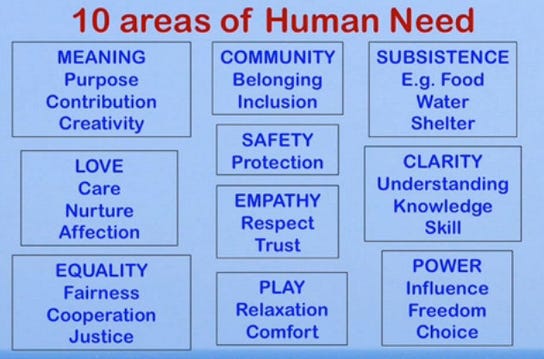Fun Explained: Fundamental Human Needs
Theres is a lot of confusion surrounding the word "Fun". This article aims to answer the questions about what it is, what it means and how to make it useful.

Theres is a lot of confusion surrounding the word Fun. This article aims to answer the questions about what it is, what it means and how to make it useful as information.

To do this, I need to explain what are Fundamental Human Needs, a concept first developer by the Chilean economist Manfred Max-Neef, which was then further refined, humanized and made more understandable by Marshall B. Rosenberg through his work in Nonviolent Communication.
I think this is one of the vital parts for the holy grail of game design.
Fundamental Human Needs
Have you ever wondered why we humans play video games?
Have you ever wondered why do we do anything ever in life?
Have you ever wondered what "fun" really means?
Have you ever wondered why some games flop despite amazing effort put into them?
Have you ever wondered why some games succeed despite how simple or trashy are?
I did wonder and I sought answers for these questions.
The answers I found all converged to a single unifying factor, fundamental human needs.
These are the core of the entire human experience, a window to understand human beings and their behaviour. As a design tool, it is indispensable, surpassing user testing and analytics to figure out if a design is valid or not.
It is also incredibly useful in outright foreseeing consequences of a design for the short and long term. For business sustainability, this knowledge is of great importance. Also, during user feedback it reveals the underlying truth behind the words and body language of a player/tester.

Quick crash course on the basics of fundamental human needs is as follows:
All human beings share the same needs
Our world offers sufficient resources for meeting everyone's basic needs
All actions are attempts to meet needs
Feelings point to needs being met or unmet
All human beings have the capacity for compassion
Human beings enjoy giving
Human beings meet needs through interdependent relationships
Human beings change
Choice is internal
Strategies to meet needs
Actions to meet needs are called “strategies”. The reason why people and cultures seem so different from one another is because they all have developed their own strategies that they use to try to meet their needs, with varying success.
The strategies available to any person or culture are based on their circumstances; where they grew up, who raised them, what education they had, what happened in their life and what information was available to them at the time.
Strategies can be smart, flawed, useless or dumb. People learn, forget and give up on strategies based on their percieved effectiveness. This is why and how people change as they live life.
Smart strategies get needs met successfully.
Flawed strategies meet some needs, but violate other needs.
Useless strategies fail to satisfy needs, but atleast doesn't make things worse.
Dumb strategies make the situation worse and also do not satisfy needs.
These are the fundamental human needs that all humans have:

Basically, anything that any human being does, is to meet fundamental human needs. That includes video games too. People play video games to satisfy their fundamental needs.
Playing video games is a strategy to meet human needs.
The word “Fun” means the satisfaction of human needs.
Implications
Satisfying human needs is a very broad idea. As a result, people may end up using the word "fun" as a shorthand to describe one or more of their needs got met by the activity they participated in, even if that activity paradoxically defies the common idea of fun, such as a horror experience, a tragedy or mundane routine.
This is the reason why games like Euro Truck Simulator, Undertale, Gone Home, The Walking Dead, Brothers: A Tale of Two Sons, Silent Hill, Farmville, Cookie Clicker, LISA, Flappy Bird, Idle Games, Resident Evil 7 and many "unconventional" games that seemingly appear to have nothing "fun" about them (joyful, playful, relaxing, exciting, happy), yet still have reached high levels of popularity and profit.
So if you approach game design from the point of view to attempt to meet fundamental human needs to enrich a player's life by offering them a new smart strategy to do so, instead of chasing for the traditional elusive "fun factor" of your game, then you are far more likely to arrive at a design that will become a hit game and a critical success.
Meanwhile in testing games, if someone says something is fun, it means its satisfying one or more of their fundamental needs something. If a tester says something in unfun, then it means something in the game is violating one or more fundamental human needs for that tester person. You can drill down why they think something is fun or unfun by applying empathy to listen to their feelings, which will point to their fundamental human needs. This can give you really good actionable data to figure out what rocks or sucks about the current design of your game.
Check out the links below for NVC videos to learn how to do empathy properly and learn more about fundamental human needs and feelings.
For further information, I highly recommend these three videos that go deep in explaining human behaviour, feelings and needs in a very coherent, step-by-step style that feels human, relatable and easily understood:
https://www.youtube.com/watch?v=52EoZzfGV-o (Basics)
https://www.youtube.com/watch?v=l7TONauJGfc (Live workshop)
https://www.youtube.com/watch?v=O4tUVqsjQ2I (In-depth)
These are the basis for the actual holy grail of game design. If you can grasp the information in these videos, your capacity to understand users and how to design for them becomes unstoppable.
Also, here is a list of feelings and needs. Very useful reference:
https://www.cnvc.org/sites/default/files/feelings_inventory_0.pdf
https://www.cnvc.org/sites/default/files/needs_inventory_0.pdf
Read more about:
BlogsAbout the Author(s)
You May Also Like







.jpeg?width=700&auto=webp&quality=80&disable=upscale)








